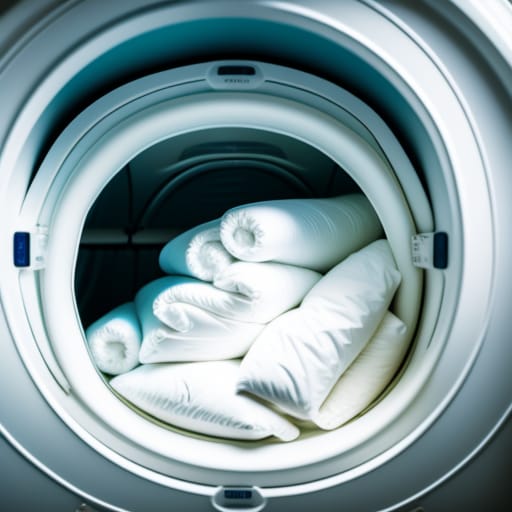Having a down comforter can make your bed feel like a luxurious, fluffy cloud. But keeping it clean and dry is key to ensuring it stays that way. Proper drying is especially important for down comforters to avoid damage, odor issues, and other problems. Read on to learn the ins and outs of safely and effectively drying your down comforter at home.
Why Proper Drying Matters
Drying your down comforter correctly after washing helps:
- Restore the loft and fluffiness of the down fill. Wet down loses its ability to trap air and provide warmth and comfort.
- Prevent mildew and mold growth. Excess moisture encourages bacterial growth.
- Avoid clumping and matting of the down. Wet feathers can clump together into hard masses.
- Minimize shrinkage that reduces the comforter’s ability to cover the bed.
- Extend the life of the comforter by protecting the materials.
- Avoid musty odors from moisture buildup.
Proper drying helps your down comforter last for many years and retain its warmth, softness and comfort.
What Is a Down Comforter?
Before we dive into drying methods, let’s review what exactly down comforters are and what makes them unique:
- Down comforters are filled with down, the soft underlayer of feathers from ducks, geese or other waterfowl.
- Down consists of tiny three-dimensional structures called plumules that trap air and provide exceptional insulation.
- Down is very lightweight yet can expand to provide substantial warmth for its weight.
- Comforters with a higher percentage of down (600 to 800 fill power) are warmer, fluffier and more expensive.
- Down is also breathable, wicking away sweat to keep sleepers comfortable.
- Alternative down comforter fills include synthetic options like polyester, and vegan options using plant-based materials.
Pre-Drying: Washing and Inspecting
Before drying your down comforter, it’s important to properly wash it and check for any damage:
- Use the right detergent like down-specific wash or a mild liquid detergent. Avoid regular powder detergents.
- Select the delicate cycle on your washing machine and cold water.
- Check for holes, tears or loose seams and repair if needed. Exposed down can escape through damaged areas when drying.
- Make sure the comforter is thoroughly rinsed of all detergent to avoid residue.
Air Drying Your Down Comforter
Air drying is the best method for safely drying down comforters at home. Here’s how:
- Hang or lay the comforter out indoors in a room with good air circulation.
- Make sure it’s completely spread out to allow all areas to dry.
- Rotate or flip the comforter periodically for even drying.
- Depending on humidity levels, air drying can take 1-3 days for a queen or king size comforter.
- Avoid direct sunlight which can damage and fade the outer fabric.
- Check that the comforter is fully dry before putting it away to prevent mildew.
Air drying avoids potential damage from machine drying and lets the down fully loft and fluff.
Drying in a Machine
You can machine dry your comforter but extra care should be taken:
- Use a large capacity dryer so the comforter can tumble freely.
- Add a few dryer balls to help separate and fluff the down. Wool balls work best.
- Choose the low heat delicate setting. High heat can damage the down and fabric.
- The drying cycle can take 2-3 hours for a large comforter. Periodically pause to redistribute and fluff.
- Remove immediately when dry and avoid over-drying which can diminish loft.
- Consider taking oversized comforters to a laundromat with large commercial dryers.
Machine drying requires close monitoring but can work well if done carefully.
Step-by-Step Machine Drying
Follow these key steps for safely machine drying a down comforter at home:
1. Load Properly
- Don’t ball up or cram the comforter – evenly distribute in drum.
- Add 3-5 dryer balls to help separate and aerate down.
2. Set Dryer Properly
- Choose low heat delicate cycle.
- Set time for 60-90 minutes initially.
3. Periodically Pause and Redistribute
- Stop the dryer every 45-60 minutes.
- Manually redistribute and fluff up fill.
- Re-start dryer and check frequently until fully dry.
4. Remove Immediately Once Dry
- Over-drying can damage the down’s loft.
- If still damp, resume drying in 15 minute increments.
Alternative Drying Methods
If air or machine drying won’t work, you can try these other options:
- Line drying outside if you have suitable weather. Ensure the comforter is fully secured.
- Drying on a clothes drying rack indoors. Opt for a large, sturdy rack.
- Laying flat on towels or blankets on the floor or bed. Flip periodically.
- Draping over multiple chairs to elevate and allow air circulation underneath.
These may take longer but are good alternatives when you can’t air or machine dry.
Post-Drying Care
Once your down comforter is fully dried, a few extra steps will help revive its fluffiness:
- Manually shake and fluff the comforter to fully loft the down.
- Tumble dry on air fluff setting with dryer balls for 10-15 minutes to fluff.
- Avoid folding or compressing for 24-48 hours to allow loft recovery.
- Store in a breathable cotton cover, not plastic.
Proper post-drying care helps your comforter regain its cloud-like loft and warmth.
Drying Extra Large Comforters
For oversized comforters like California King, drying can be challenging:
- Standard home dryers may not accommodate the full size.
- Air drying takes 4+ days given the thickness and density.
- The inner parts or middle section may remain damp.
Solutions include:
- Take to a laundromat with large commercial dryers.
- Air dry in multiple phases, fully drying one half then the other.
- Use a drying rack and rotate sides periodically.
- Carefully machine dry in small loads and intervals over multiple days.

Drying Delicate Materials
Extra care should be taken when drying delicate comforters filled with:
Mulberry Silk
- Air dry only, out of direct sunlight. Silk is prone to fading.
- Lay flat or hang to dry fully – can take 1-2 days.
- Avoid any heat drying as silk is heat-sensitive.
Wool
- Machine dry on cool delicate setting only. Wool can shrink if overheated.
- Use dryer balls to separate and fluff the wool fibers.
- Lay flat to air dry instead of hanging to avoid stretching wool.
Troubleshooting Common Drying Issues
Dealing with Shrinkage
To help prevent shrinking:
- Stick to low heat delicate settings when machine drying.
- Don’t over-dry comforters past complete dryness.
If shrinkage does occur:
- Soak in lukewarm water and gently stretch and resize.
- Add hair conditioner or fabric softener during the rinse cycle when washing.
Eliminating Odors
Musty smells can develop if drying is incomplete. To freshen:
- Sprinkle baking soda and allow to sit before vacuuming off.
- Add dryer sheets or wool dryer balls scented with essential oils.
- For severe odors, take to a professional cleaner for ozonation.
When to Seek Professional Help
While drying a comforter at home is usually straightforward, consider professional assistance for:
- Oversized comforters that home equipment cannot accommodate.
- Severely soiled comforters needing stronger cleaning methods before drying.
- Heavily damaged comforters where the fill is compromised or leaking out.
- Lingering odor issues that require advanced treatments to eliminate smells from mildew or smoke.
- Cases where home drying attempts have failed and resulted in damage or shrunken comforters.
Choosing a Reputable Professional Service
When taking your comforter to a professional cleaner or laundry service, look for:
- Experience specifically with down – ensures proper wash and dry methods are used.
- Large commercial equipment like washers and dryers for bulky items.
- Green earth-friendly cleaning processes, no harsh chemicals.
- Good reviews for service and results.
- Reasonable pricing – professional drying a comforter costs $25-$100 depending on size.
- Trustworthy reputation and longevity in business.
Eco-Friendly Drying Tips
When drying your down comforter, be kind to the planet by:
- Line or rack drying instead of using a dryer.
- Choosing a detergent made of plant-based ingredients. Avoid chemicals.
- Using wool dryer balls instead of single-use dryer sheets.
- Opting for professional green dry cleaners. Avoid toxic chemical processes.
- Repairing any feathers escaping through small holes or tears to avoid losing fill.
- Donating or recycling comforters no longer usable instead of landfilling.
Safety Precautions
Take these precautions when drying your down comforter:
- Never leave a dryer unattended – risk of fire if overheating occurs.
- Clean lint filter before each load to allow for airflow and prevent buildup.
- Allow comforter to fully cool before storage to avoid mildew.
- Use mild detergent if you have skin sensitivities to avoid reactions.
- Hang high or fold while drying if small children or pets can access to prevent injury.
Proper drying done safely will prolong your investment in a quality down comforter.

Conclusion
Drying a down comforter properly is an important process to ensure longevity of use and comfort. Focus on air drying laying flat or draped whenever possible, or use a dryer on delicate low heat if needed. Avoid direct sunlight, use dryer balls to separate fill and redistribute fill mid-cycle. With the right techniques, you can keep your down comforter freshly fluffed and free of odor or damage. A little time invested in proper home drying pays off in the long run with a cozy, durable down comforter providing comfort and warmth for years to come.
Frequency Asked Questions
What is the best way to dry a down comforter at home?
The recommended method is to thoroughly air dry your down comforter. Lay it flat or hang to dry in a room with good air circulation. Make sure no areas are bunched up and the comforter can dry evenly throughout. Air drying avoids potential heat damage and lets the down fully loft.
How long does it take to dry a down comforter?
Drying times vary based on the size of your comforter and drying method. Air drying can take 1-3 days for a queen or king comforter. Machine drying on low may take 2-3 hours but requires checking and redistributing the down periodically. Larger California king comforters take proportionally longer.
Should I use tennis balls when drying my down comforter?
Tennis balls can damage delicate fabrics. Instead use wool or synthetic dryer balls, which gently separate and fluff the down. Use 3-5 balls for large comforters.
What temperature setting should I use to machine dry down?
Always select the low heat delicate setting when machine drying down comforters. High heat can damage or shrink the down. Allow the comforter to air fluff for 10-15 minutes after drying to fully restore loft.
How can I avoid shrinkage when drying my down comforter?
To minimize shrinkage, air dry or use the lowest heat setting on the dryer. Don’t over-dry the comforter past complete dryness. Adding fabric softener or conditioner during washing can also help reduce shrinkage.
What causes odor in down comforters and how can I eliminate it?
Mildew and bacterial growth from incomplete drying can cause odors. Make sure the comforter is fully dry before storing. To freshen, sprinkle with baking soda, use scented dryer balls, or take to a professional for ozonation if odors persist.








